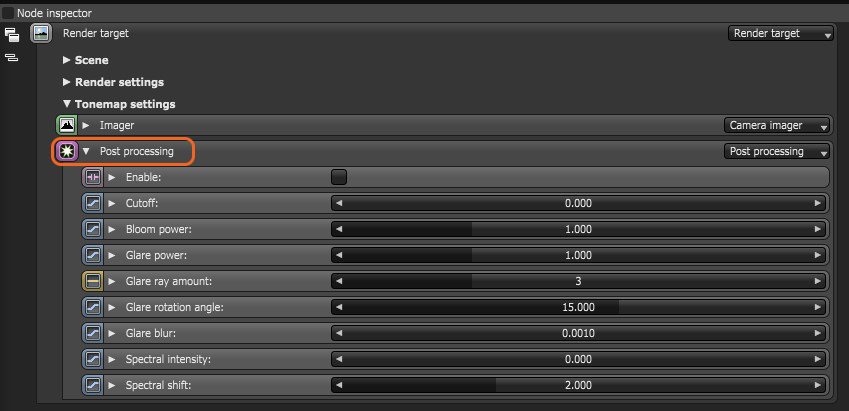
Post ProcessingEffects such as Bloom and Glare that are applied after a scene has been rendered. provides a number of effects that are applied once the Kernel has completed rendering. The Post Processing parameters are accessible from the Render Target node without adding and connecting a specific Post Processing node to the scene. It can be found under the Tonemap Settings in a Render Target node (Figure 1).

Figure 1: Accessing the Post Processing effects from the Render Target node
A Post Processing node can also be attached to a Render Target node for easier access to the post effects (Figure 2).The Post Processing node can be found by right-clicking in the Octane Nodegraph Editor window and navigating to the Render Settings category of nodes.

Figure 2: Adding a Post Processing node to a Render Target node
Enable - Enables post-processing effects on the render. Post-processing is disabled by default.
Cutoff - Applies bloom/glare to pixel values above the Cutoff value.
Bloom Power - Controls the size and intensity of the halo around the sun, light source, or reflective GlossyThe measure of how well light is reflected from a surface in the specular direction, the amount and way in which the light is spread around the specular direction, and the change in specular reflection as the specular angle changes. Used for shiny materials such as plastics or metals. materials.
Glare Power - Controls the size and intensity of the glare originating from reflective Glossy materials.
Glare Ray Amount - Controls the number of visible rays radiated or reflected.
Glare Rotation Angle - Adjusts the glare rotation relative to the object. A glare angle of -90 and 90 results to one main horizontal glare, and a glare angle of 0 results to one main vertical glare.
Glare Blur - Controls the glare sharpness. Smaller values result in a crisp linear glare, and this is softened with higher values.
Spectral Intensity - Adjusts the intensity distribution of the rays across a source. This affects the radiant energy's brightness.
Spectral Shift - Adjusts the spectrum displacement as the source's emitted light frequency changes. The shift is evident by a color change, similar to the doppler effect.